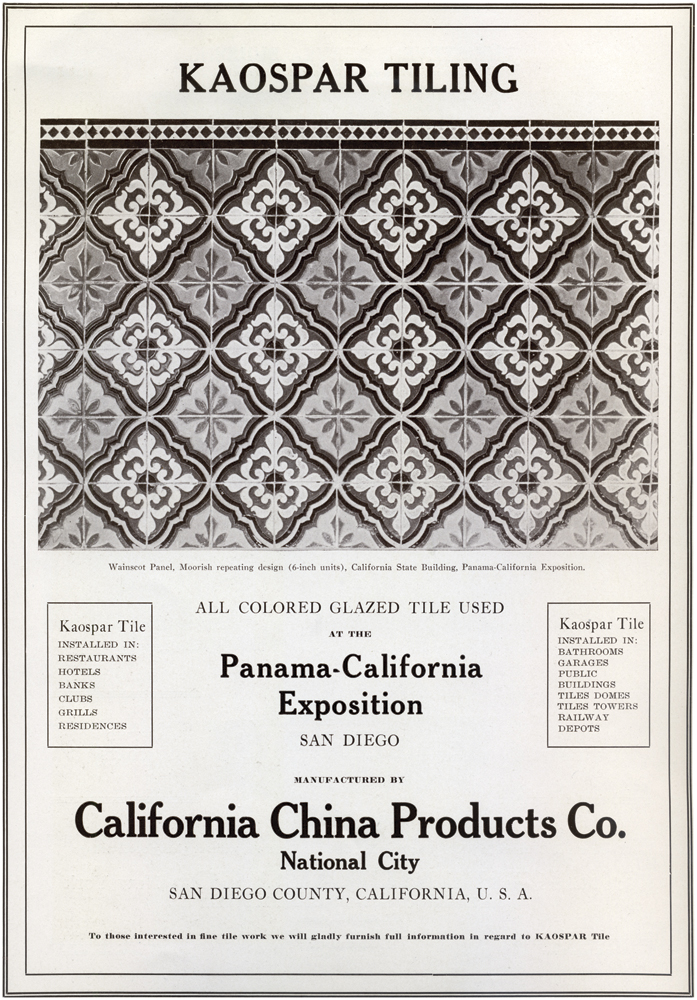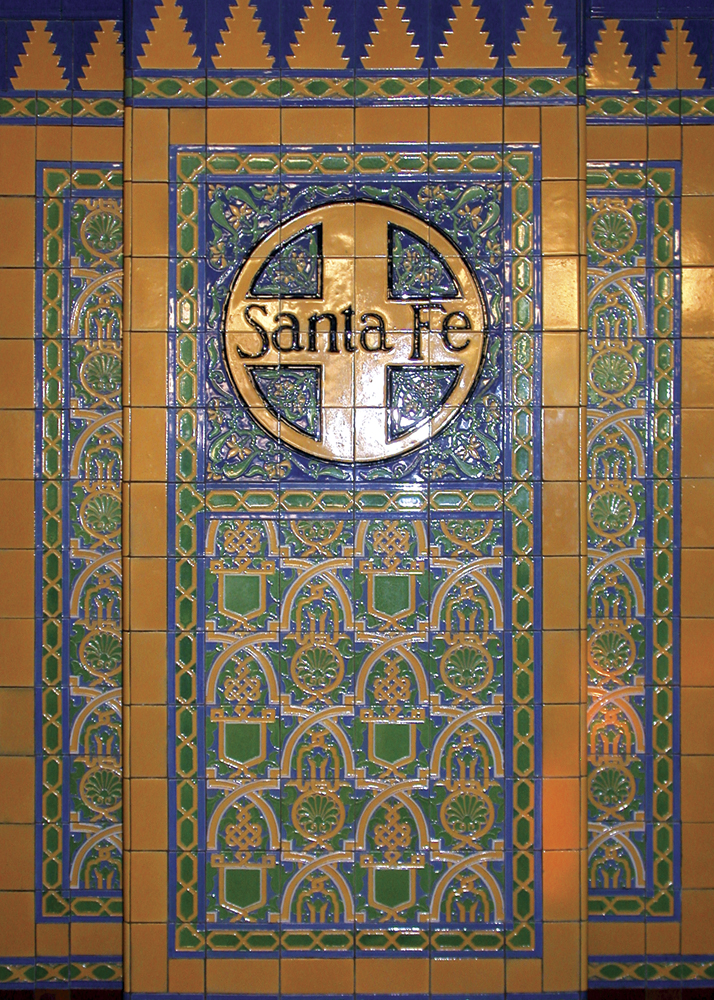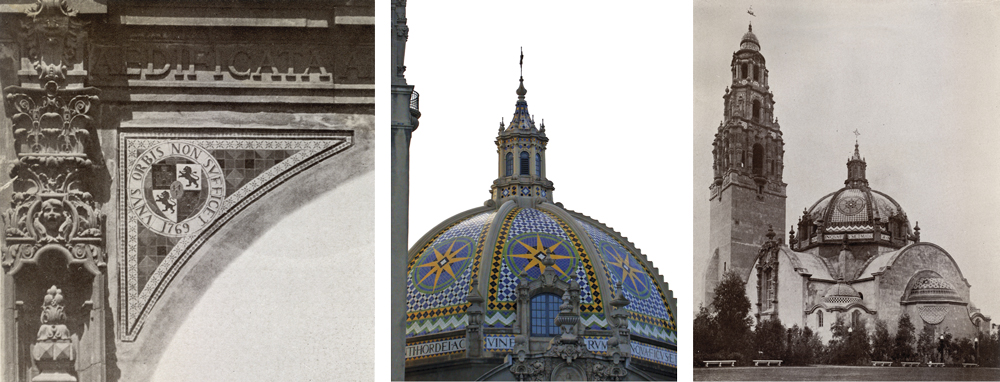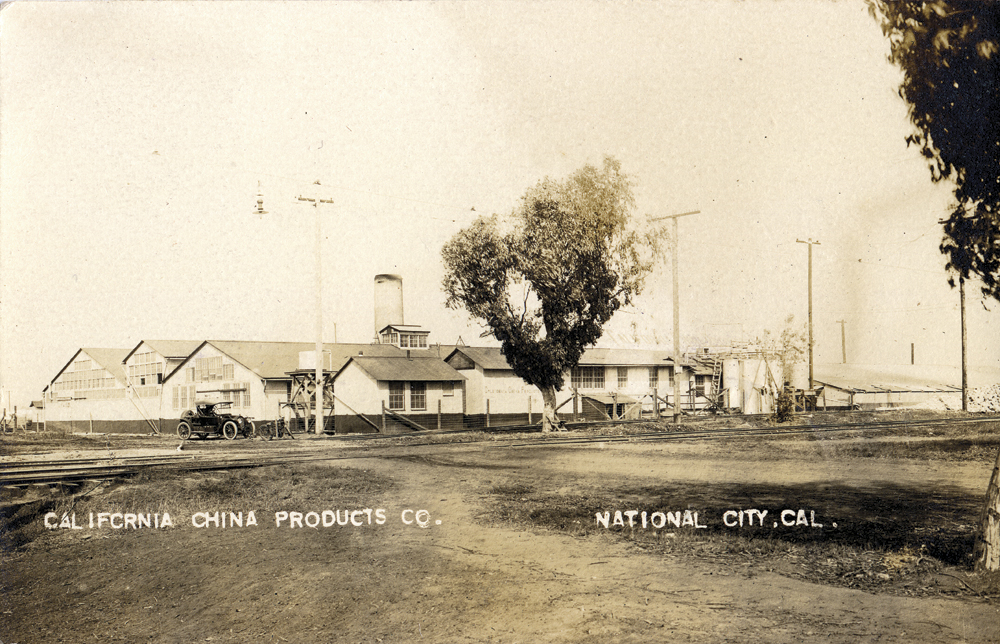|
California China
Our Claim to Tile Fame
By Alana Coons

CCPco advertisement from The Architect, June, 1915
|

Part of a wall at the Santa Fe Depot showing extensive use of CCPco tile
|
Tiles shaped much of Southern California's architecture and design through the early part of the 20th century into the 1940's. During this time tiles were used effectively and in abundance in both public and private spaces with an astonishing array of color, texture and designs. The importance of this form of art is just now being widely embraced with the kind of fervor that a long overdue discovery often inspires.
In 1987, I wrote a weekly column for the National City Star News on South Bay history. It was then that I first discovered and wrote about California China Products Company (CCPCo). What first caught my eye were the principles involved; the firm was established by Walter Nordoff and his son Charles. I wondered could this be the same Walter Nordoff who co-wrote Mutiny on the Bounty, and other classics. I soon came to find out that it was indeed one and the same. But far more interesting, as I was to learn, was the story of this early California china factory and their pivotal role in the use of decorative tile in California architecture.
It began in 1911 when Walter and Charles B. Nordhoff, along with partner and mineralogist John H. McKnight formed the company after a study of geological conditions of San Diego County convinced the partners that all was favorable for the manufacturing of fine porcelain and china wares. Although their original idea was to manufacture fine porcelain products, it was their brilliant, polychromatic Hispano-Moresque style faience tile that would earn CCPCo its fame.
It has been said that CCPCo faience tile practically revolutionized Southern California's architectural landscape. With its introduction coinciding with the emergence of the Spanish Colonial Revival movement, CCPCo made its mark on tile heritage. Despite its brief six-year life span, they were one of the most innovative tile manufacturers in California. The matte glazed tiles with their rich deep colors, matched only by their durability and usefulness as an outdoor material, were well received; they set the standard for succeeding generations of tile makers.
Their work can best be seen at two of our landmark buildings, the Bertrum Goodhue designed California Building at Balboa Park and the Santa Fe Railway Depot downtown. With an estimated 10,000 tiles used for the buildings of the 1915 Panama-California Exposition, and produced by several companies, it is on the California building that CCPCo tiles are seen best in the massive sixty-foot high dome, with its glorious compass rose designs and 180-foot tower, it has become one of the most beloved and photographed buildings in the park.
The spectacular display of the company's work at the 1914-15 Santa Fe Railway Depot, designed by the San Francisco-based architectural firm of Bakewell and Brown, is its most prominent feature, the pair of domed towers on either side of the entry arch. Here you can really see up close and personal the extensive use of CCPCo Hispano-Moresque tile.
The interior of the impressive waiting room is almost entirely tiled. Historian Alex Bevil describes this room beautifully in his 1999 award-winning article The History of the California China Products Company, in the "Journal of San Diego History,"
Wainscots covered in rich geometric patterns of green, blue, yellow, white, and black. In each of their pilasters, set in green and black tile on a blue background, is the famous cross and logo emblem of the Santa Fe Railway. Other decorative features include green leaf and yellow squash flower-patterned tiles, interwoven light blue Moorish strap pattern panels, and an interwoven hexagonal chain of yellow-tinged tile. Framing the composition are twin horizontal friezes of alternating golden-yellow and medium blue stylized ziggurats along the wainscot's top and bottom. All of these effects combine to give the feeling of viewing a fine Persian rug. Between the wainscots, although worn by eighty-two years of foot traffic, the original matte glaze floor or quarry tiles still perform yeoman duty.
It is hard to believe it, but this iconic building is one that SOHO has had to save from demolition no less than twice.

(Left to right) Left side of arch, California State Building, Panama-California Exposition. The tile was manufactured by CCPco; Current photo of the California State Building dome; View looking southwest of California Building, Panama-California Exposition, Cram, Goodhue & Ferguson, Architects. From The Architect, June 1915

California China Products factory at 7th and 6th Avenues and 12th and 10th Streets. On June 10, 1911 the National City News proclaimed it as "an ideal location for a factory. It is within one block of the waterfront on streets open to the bay and is practically on the line of the Santa Fe Railroad, the San Diego and Arizona Railroad, the San Diego Southern Railway and the electric line."
While California China may be our hometown favorite, most tiles used in historic homes in San Diego came from other such significant companies as Pacific Clay Products; Gladding, McBean; Batchelder Tile; Taylor Tilery; D & M Tile; Hispano-Moresque Tiles; Malibu Potteries; and Catalina Pottery among others. Local architects such as Richard Requa, Lillian Rice and Cliff May made great use of them.
Until about 1940, California was the leading producer of utilitarian, art, and architectural terra cotta tile in the United States with more than 40 companies producing art or commercial tiles in California between 1910 and 1940. The California tile industry ended with the Great Depression, the World War II conversion of the many tile manufacturers to utilitarian porcelain manufacturers, and the rise of modernist design. |
MORE FROM THIS ISSUE
From the Editor
Reconstructing Balboa Park's "Dream City"
Names & Milestones in the History of Prado Buildings
10 Vanished Balboa Park Landmarks
Historic Losses: Fires Devastate San Diego San Diego County's Historic Sites
California Tile: Our Claim to Tile Fame
The Use of Tile in the Home
Tile Resources
President's Message
Reflections
In Memoriam - Beth Montes
The Beth Montes Memorial Internship & Outreach Fund
Book Reviews
Letters to the Editor
Lost San Diego
Strength in Numbers
Advertisements
DOWNLOAD full magazine as pdf (21mb)
|







